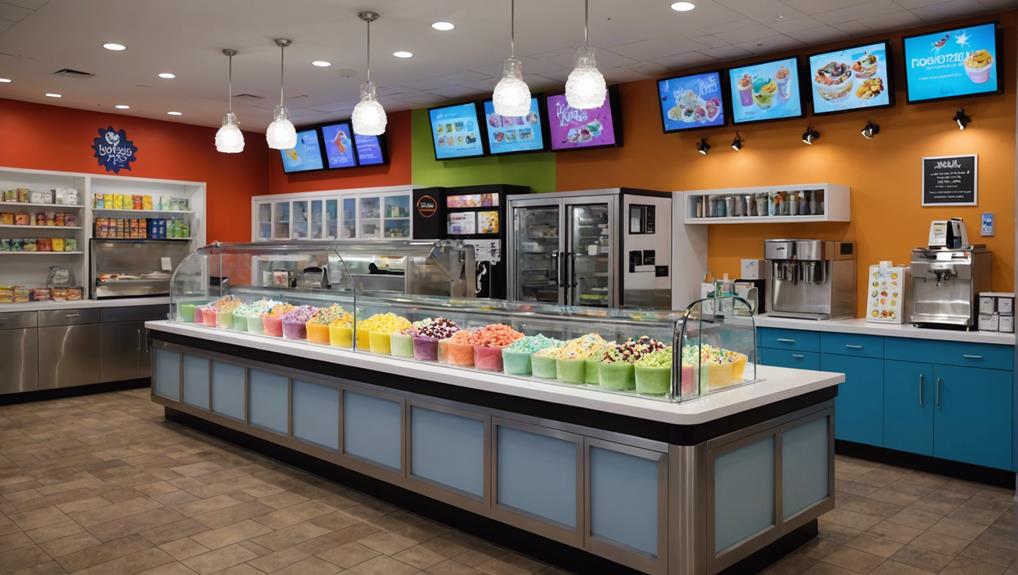Securing financing for your frozen yogurt franchise involves several critical steps. To begin with, assess your financial health by calculating net worth and liquidity. A strong credit score enhances your chances of securing loans. Funding options include bank loans, personal savings, and franchise-specific financing programs. SBA loans are a popular choice due to their favorable terms and lower interest rates. Thorough business planning and financial projections are crucial for attracting investors and ensuring financial stability. Evaluating costs and potential return on investment helps in making informed decisions. Understanding these elements guarantees you are well-prepared to navigate the financing landscape effectively. Gain further insights by continuing.
Key Takeaways
- Calculate your net worth and assess liquidity to determine initial investment readiness.
- Evaluate your credit score to improve creditworthiness for potential financing.
- Explore SBA loans for favorable interest rates and terms tailored for franchise financing.
- Compare traditional bank loans, SBA loans, and franchisor financing to find the best fit.
- Prepare a comprehensive business plan with financial projections to attract investors and ensure financial stability.
Assessing Your Financial Situation
To determine your ability to finance a frozen yogurt franchise, begin by thoroughly analyzing your personal financial situation, including net worth and liquidity. Net worth is calculated by subtracting your total liabilities from your total assets. This metric provides a snapshot of your financial health and indicates how much capital you can potentially invest in the franchise.
Liquidity is another important factor, as it measures your ability to convert assets into cash quickly. High liquidity guarantees that you can meet the franchise's initial costs and ongoing operational needs without financial strain. Additionally, evaluate your credit score, an essential indicator of your creditworthiness. A strong credit score can enhance your ability to secure favorable loan terms, which is often necessary for substantial investments like a franchise.
Existing debts and financial obligations should also be meticulously reviewed to understand their impact on your overall financial stability. Finally, identify all potential funding sources, including savings, investments, and partnerships, to make sure you have adequate capital. Consulting with financial advisors or franchise consultants can further refine your financial assessment, providing a detailed view of your readiness to engage in franchise ownership. This rigorous analysis will lay the groundwork for a financially sound investment in a frozen yogurt franchise.
Exploring Funding Options
Several funding options are available for aspiring frozen yogurt franchise owners, each with distinct advantages and considerations. The initial investment required often includes the franchise fee, equipment, inventory, and working capital, collectively forming the startup costs. Analyzing various financing options can help determine the most feasible path to ownership within the chosen franchise model.
Traditional bank loans are a common choice, typically offering competitive interest rates and structured repayment terms. However, securing such loans often requires a strong credit history and collateral. Alternatively, personal savings provide complete financial control but may limit the investment amount. Crowdfunding has gained traction as a modern approach, enabling potential owners to gather small investments from numerous backers, although this can be time-consuming and uncertain.
Franchise-specific financing programs are another viable option. Many franchisors offer in-house financing or partnerships with preferred lenders, potentially reducing the initial financial burden. These programs may include favorable terms tailored to the franchise model, easing the investment required.
Private investors or venture capital can also be considered, especially for those with a strong business plan and growth potential. While this option can provide substantial capital, it often comes with diluted ownership and decision-making influence.
SBA Loans for Franchises

When considering SBA loans for financing a frozen yogurt franchise, it is essential to understand the eligibility requirements, application process steps, and interest rate structure. These loans typically offer low-interest rates and longer repayment terms, making them a viable option for franchisees. Additionally, the credibility of the SBA can facilitate easier qualification and provide greater financial stability.
Eligibility Requirements Explained
Securing an SBA loan for your frozen yogurt franchise requires meeting specific eligibility criteria, including being a for-profit business and demonstrating the ability to repay the loan. SBA loans are highly sought after due to their competitive rates and extended repayment terms, making them ideal for franchise financing. To qualify, franchises must operate within the United States and satisfy various financial metrics to prove their creditworthiness.
One primary requirement is that the franchisee must provide a personal guarantee, which underscores their commitment to repaying the loan. Additionally, SBA loans can cover a wide range of franchise costs, including franchise fees, equipment purchases, working capital, and real estate expenses. Importantly, SBA loans may finance up to 85% of these costs, reducing the financial burden on the franchisee.
To better understand the eligibility requirements, refer to the table below:
| Eligibility Criteria | Details |
|---|---|
| Business Type | Must be a for-profit business |
| Location | Must operate within the United States |
| Ability to Repay | Must demonstrate financial capability to repay the loan |
| Personal Guarantee | Required from the franchisee |
| Coverage of Costs | Up to 85% of franchise costs, including fees, equipment, etc. |
Meeting these eligibility requirements is essential for securing SBA financing and successfully launching a frozen yogurt franchise.
Application Process Steps
Understanding the eligibility requirements forms the foundation for the next critical stage: maneuvering through the detailed application process for SBA loans for your frozen yogurt franchise. This process begins with the submission of a thorough loan application, which must include a detailed business plan and detailed financial statements. Additionally, personal background information is required to assess the creditworthiness and managerial capabilities of the franchisee.
A vital aspect of the application process is the thorough review of the franchise agreement. This document outlines the terms, fees, and obligations associated with the franchise, providing lenders with essential insights into the financial commitments and operational framework of the business. Franchisees should be prepared to disclose any required fees and ongoing obligations stipulated within this agreement.
Collateral is another key consideration in securing an SBA loan. Franchisees may need to pledge personal assets or real estate as security for the loan, thereby mitigating the lender's risk. The SBA's guarantee on these loans further enhances the likelihood of approval by reducing the perceived risk for lenders. By adhering to these stringent application steps, franchisees can better position themselves to obtain the necessary financing for their frozen yogurt business.
Interest Rates Overview
Interest rates for SBA loans extended to franchisees are generally more favorable than those of traditional bank loans, offering a prime rate plus markup structure that typically ranges from 2.25% to 4.75%. This advantageous rate structure is especially beneficial for entrepreneurs entering the frozen yogurt market, where initial capital expenditures for franchise fees, site selection, and training programs can be significant. The lower interest rates reduce the overall cost of borrowing, making SBA loans an attractive option for funding a new franchise or expanding an existing one.
The key characteristics of SBA loans for franchises include:
- Extended Repayment Terms: SBA loans can offer repayment terms up to 25 years for real estate, thereby lowering monthly payments and easing cash flow management for franchisees.
- Regulated Interest Rates: The Small Business Administration sets maximum interest rates, ensuring that borrowers benefit from competitive, market-driven rates.
- Comprehensive Financing Options: SBA loans cover a wide range of financing needs, from initial franchise fees and site selection costs to training programs and operational expenses.
Traditional Bank Loans
Traditional bank loans are a prevalent method for financing the initial costs associated with launching a frozen yogurt franchise, including franchise fees and equipment purchases. These traditional financing options are particularly attractive due to their competitive interest rates and well-defined terms. For prospective franchisees, understanding the nuances of these loans is essential to effectively managing startup expenses.
To secure a traditional bank loan, franchisees must typically provide collateral and meet specific credit requirements. Collateral can include personal assets or business property, which reduces the bank's risk. Additionally, banks assess credit history to determine the applicant's ability to repay the loan. Here is a summary of key components involved in obtaining traditional bank loans:
| Component | Details | Importance |
|---|---|---|
| Franchise Fees | Covers licensing and initial startup costs | Essential for franchise ownership |
| Equipment Purchases | Financing for essential machinery and shop fittings | Critical for operational readiness |
| Competitive Interest Rates | Lower costs of borrowing | Enhances financial feasibility |
| Collateral Requirement | Personal or business assets to secure the loan | Minimizes lender's risk |
Traditional bank loans offer a straightforward pathway for securing necessary funding, making them a viable option for many aspiring frozen yogurt franchise owners. By meeting collateral and credit requirements, franchisees can access the capital needed to launch their business successfully.
Alternative Financing Solutions

A variety of alternative financing solutions, such as SBA loans, franchisor financing, equipment leasing, and crowdfunding, offer diverse pathways for securing capital to launch a frozen yogurt franchise. These options provide franchisees with flexible and potentially more accessible funding compared to traditional bank loans. Below are some key alternatives:
- SBA Loans: These government-backed loans often come with favorable terms and interest rates, making them a viable option for small businesses. The Small Business Administration (SBA) guarantees a portion of the loan, reducing the risk for lenders and facilitating access to capital for franchisees.
- Franchisor Financing: Some franchisors offer direct financing to their franchisees. This option can streamline the funding process, as the franchisor is already familiar with the business model and operational requirements. Additionally, franchisor financing may come with more lenient terms compared to traditional bank loans.
- Equipment Leasing: Acquiring equipment through leasing can considerably lower the initial capital outlay. This approach allows franchisees to allocate their financial resources more efficiently, focusing on other startup costs. Leasing agreements often include maintenance and upgrades, ensuring that the equipment remains up-to-date.
Preparing Your Business Plan
When preparing your business plan, it is crucial to present a thorough market analysis, detailing your target demographic and competitive landscape. This should be followed by precise financial projections, including initial investment, operating costs, and expected revenue streams. Additionally, clearly outline your operational strategy, emphasizing your franchise model, brand differentiation, and menu offerings to demonstrate the viability and growth potential of your frozen yogurt franchise.
Market Analysis Importance
Conducting a thorough market analysis is essential for evaluating the viability and potential profitability of your frozen yogurt franchise. This analysis serves as the cornerstone for understanding the frozen yogurt industry, customer demographics, and ideal location selection. It provides vital data that aids in identifying market trends, which in turn inform strategic decisions that shape your business plan.
A well-executed market analysis involves several key components:
- Industry Trends: Analyzing the frozen yogurt industry trends helps you understand the current market dynamics, including growth rates, seasonal fluctuations, and emerging consumer preferences. This enables you to tailor your offerings to meet market demands effectively.
- Customer Demographics: Detailed insights into customer demographics—such as age, income level, and lifestyle preferences—allow you to target your marketing efforts more precisely. Knowing your customers helps in crafting promotional strategies and customizing the product assortment.
- Location Selection: Choosing the right location is pivotal for your franchise's success. A market analysis helps identify high-traffic areas and regions with a high demand for frozen yogurt, ensuring ideal customer reach and sales potential.
Incorporating these insights into your business plan not only strengthens your strategic framework but also enhances your appeal to potential investors and lenders.
Financial Projections Outline
Drawing on the insights gained from your market analysis, the next essential step involves preparing a detailed financial projections outline to underpin your business plan. This outline is pivotal for your frozen yogurt franchise, as it provides a thorough view of your expected revenue, expenses, and profits. By detailing these financial projections, you not only create a roadmap for your business's financial health but also offer potential investors and lenders the data they need to assess the viability of your franchise.
A well-prepared financial projections outline will include a variety of key elements. These typically encompass projected income statements, cash flow forecasts, and balance sheets. Each of these components plays a critical role in setting realistic financial goals, making informed strategic decisions, and identifying potential financial risks. Accurate financial projections are essential for securing the necessary financing, as they demonstrate the long-term profitability and sustainability of your frozen yogurt franchise.
Moreover, these projections allow you to adjust your business plan dynamically, responding to market changes and operational challenges. Ultimately, the financial projections outline serves as a crucial tool for ensuring the financial stability and growth of your frozen yogurt franchise.
Operational Strategy Essentials
Developing a robust operational strategy is essential for ensuring the efficient and effective management of your frozen yogurt franchise. A well-prepared business plan not only serves as a roadmap for your operations but also plays an important role in securing financing.
To create a thorough business plan, consider the following key components:
- Franchise Models and Initial Investment Costs: Detail the various franchise models available and outline the specific initial investment costs associated with each. This includes franchise fees, equipment purchases, and store setup expenses. Clearly articulate both the short-term and long-term financial commitments.
- Operational Processes and Revenue Projections: Establish effective operational processes that streamline daily activities and enhance productivity. Include meticulous revenue projections based on realistic sales forecasts and market conditions. This data-driven approach helps in setting achievable financial goals.
- Market and Competitive Analysis: Conduct an in-depth market analysis to identify your target demographic and gauge market demand. Complement this with a competitive analysis to understand your position relative to existing competitors. This insight is important for formulating strategies that differentiate your franchise in a saturated market.
Tips for Securing Financing

Exploring various financing options, such as SBA loans, traditional bank loans, and franchisor financing, is essential for securing the necessary capital to start your frozen yogurt franchise. SBA loans often provide favorable terms and lower interest rates, making them an attractive option. Traditional bank loans may offer higher limits but could come with stricter requirements. Franchisor financing can streamline the process, leveraging the franchisor's established relationships with lenders.
Understanding franchisee obligations is vital. These include royalty fees, marketing fund contributions, technology fees, renewal fees, and transfer fees. These obligations can impact your cash flow and should be factored into your financing strategy. Additionally, plan for additional costs such as training expenses, insurance costs, legal fees, grand opening marketing costs, and ongoing support fees. These are often underestimated but essential for operational success.
When evaluating return on investment, consider average revenue projections, profit margins, break-even analysis, and industry benchmarks. Look at franchisee success rates to gauge potential profitability. Data-driven insights into these metrics can greatly influence your financing decisions, ensuring that the chosen financing options align with your long-term financial goals. This thorough approach will enable you to make informed, strategic decisions for your frozen yogurt franchise.
Frequently Asked Questions
How Much Does It Cost to Franchise Frozen Yogurt?
The cost to franchise frozen yogurt involves an initial investment ranging from $96,350 to $632,500. This includes franchise fees, lease agreements, equipment costs, and marketing expenses, varying by franchise model and location.
Can You Get Funding for a Franchise?
Yes, funding for a franchise can be secured through various channels including personal savings, crowdfunding platforms, alternative lenders, credit unions, and angel investors, each offering unique benefits and considerations based on the franchisee's financial profile.
How Much Does a Menchies Owner Make a Year?
"A penny saved is a penny earned." Menchies owners typically achieve an annual profit between $60,000 and $100,000. Revenue potential and financial success depend on various factors, impacting business earnings and overall earning expectations.
How Much Does It Cost to Start a Yogurtland?
The cost to start a Yogurtland franchise ranges from $180,000 to $490,000, encompassing location selection, equipment expenses, staff salaries, marketing strategies, and renovation costs. Thorough financial planning and understanding these elements are essential for success.
Conclusion
Securing financing for a frozen yogurt franchise requires a thorough assessment of one's financial situation, exploration of various funding options, and meticulous preparation of a business plan. For example, a hypothetical entrepreneur could leverage an SBA loan, which offers favorable terms for small business owners, thereby facilitating initial capital outlay. By considering traditional bank loans and alternative financing solutions, the entrepreneur guarantees a diversified approach to funding, thereby optimizing the chances of securing the necessary capital for successful franchise operations.







